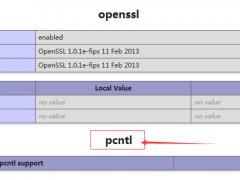1、传递任意数量的函数参数
我们在.NET或者JAVA编程中,一般函数参数个数都是固定的,但是PHP允许你使用任意个数的参数。下面这个示例向你展示了PHP函数的默认参数:
// 两个默认参数的函数
function foo($arg1 = ”, $arg2 = ”) {
echo “arg1: $arg1\n”;
echo “arg2: $arg2\n”;
}
foo(‘hello’,’world’);
/* 输出:
arg1: hello
arg2: world
*/
foo();
/* 输出:
arg1:
arg2:
*/
下面这个示例是PHP的不定参数用法,其使用到了 func_get_args()方法:
// 是的,形参列表为空
function foo() {
// 取得所有的传入参数的数组
$args = func_get_args();
foreach ($args as $k => $v) {
echo “arg”.($k+1).”: $v\n”;
}
}
foo();
/* 什么也不会输出 */
foo(‘hello’);
/* 输出
arg1: hello
*/
foo(‘hello’, ‘world’, ‘again’);
/* 输出
arg1: hello
arg2: world
arg3: again
*/
2、使用glob()查找文件
大部分PHP函数的函数名从字面上都可以理解其用途,但是当你看到 glob() 的时候,你也许并不知道这是用来做什么的,其实glob()和scandir() 一样,可以用来查找文件,请看下面的用法:
// 取得所有的后缀为PHP的文件
$files = glob(‘*.php’);
print_r($files);
/* 输出:
Array
(
[0] => phptest.php
[1] => pi.php
[2] => post_output.php
[3] => test.php
)
*/
你还可以查找多种后缀名:
// 取PHP文件和TXT文件
$files = glob(‘*.{php,txt}’, GLOB_BRACE);
print_r($files);
/* 输出:
Array
(
[0] => phptest.php
[1] => pi.php
[2] => post_output.php
[3] => test.php
[4] => log.txt
[5] => test.txt
)
*/
你还可以加上路径:
$files = glob(‘../images/a*.jpg’);
print_r($files);
/* 输出:
Array
(
[0] => ../images/apple.jpg
[1] => ../images/art.jpg
)
*/
如果你想得到绝对路径,你可以调用 realpath() 函数:
$files = glob(‘../images/a*.jpg’);
// applies the function to each array element
$files = array_map(‘realpath’,$files);
print_r($files);
/* output looks like:
Array
(
[0] => C:\wamp\www\images\apple.jpg
[1] => C:\wamp\www\images\art.jpg
)
*/
3、获取内存使用情况信息
PHP的内存回收机制已经非常强大,你也可以使用PHP脚本获取当前内存的使用情况,调用memory_get_usage() 函数获取当期内存使用情况,调用memory_get_peak_usage() 函数获取内存使用的峰值。参考代码如下:
echo “Initial: “.memory_get_usage().” bytes \n”;
/* 输出
Initial: 361400 bytes
*/
// 使用内存
for ($i = 0; $i < 100000; $i++) {
$array []= md5($i);
}
// 删除一半的内存
for ($i = 0; $i < 100000; $i++) {
unset($array[$i]);
}
echo “Final: “.memory_get_usage().” bytes \n”;
/* prints
Final: 885912 bytes
*/
echo “Peak: “.memory_get_peak_usage().” bytes \n”;
/* 输出峰值
Peak: 13687072 bytes
*/
4、获取CPU使用情况信息
获取了内存使用情况,也可以使用PHP的 getrusage()获取CPU使用情况,该方法在windows下不可用。
print_r(getrusage());
/* 输出
Array
(
[ru_oublock] => 0
[ru_inblock] => 0
[ru_msgsnd] => 2
[ru_msgrcv] => 3
[ru_maxrss] => 12692
[ru_ixrss] => 764
[ru_idrss] => 3864
[ru_minflt] => 94
[ru_majflt] => 0
[ru_nsignals] => 1
[ru_nvcsw] => 67
[ru_nivcsw] => 4
[ru_nswap] => 0
[ru_utime.tv_usec] => 0
[ru_utime.tv_sec] => 0
[ru_stime.tv_usec] => 6269
[ru_stime.tv_sec] => 0
)
*/
- ru_oublock: 块输出操作
- ru_inblock: 块输入操作
- ru_msgsnd: 发送的message
- ru_msgrcv: 收到的message
- ru_maxrss: 最大驻留集大小
- ru_ixrss: 全部共享内存大小
- ru_idrss:全部非共享内存大小
- ru_minflt: 页回收
- ru_majflt: 页失效
- ru_nsignals: 收到的信号
- ru_nvcsw: 主动上下文切换
- ru_nivcsw: 被动上下文切换
- ru_nswap: 交换区
- ru_utime.tv_usec: 用户态时间 (microseconds)
- ru_utime.tv_sec: 用户态时间(seconds)
- ru_stime.tv_usec: 系统内核时间 (microseconds)
- ru_stime.tv_sec: 系统内核时间?(seconds)
// sleep for 3 seconds (non-busy)
sleep(3);
$data = getrusage();
echo “User time: “.
($data[‘ru_utime.tv_sec’] +
$data[‘ru_utime.tv_usec’] / 1000000);
echo “System time: “.
($data[‘ru_stime.tv_sec’] +
$data[‘ru_stime.tv_usec’] / 1000000);
/* 输出
User time: 0.011552
System time: 0
*/
// loop 10 million times (busy)
for($i=0;$i<10000000;$i++) {
}
$data = getrusage();
echo “User time: “.
($data[‘ru_utime.tv_sec’] +
$data[‘ru_utime.tv_usec’] / 1000000);
echo “System time: “.
($data[‘ru_stime.tv_sec’] +
$data[‘ru_stime.tv_usec’] / 1000000);
/* 输出
User time: 1.424592
System time: 0.004204
*/
$start = microtime(true);
// keep calling microtime for about 3 seconds
while(microtime(true) – $start < 3) {
}
$data = getrusage();
echo “User time: “.
($data[‘ru_utime.tv_sec’] +
$data[‘ru_utime.tv_usec’] / 1000000);
echo “System time: “.
($data[‘ru_stime.tv_sec’] +
$data[‘ru_stime.tv_usec’] / 1000000);
/* prints
User time: 1.088171
System time: 1.675315
*/
5、获取系统常量
// this is relative to the loaded script’s path
// it may cause problems when running scripts from different directories
require_once(‘config/database.php’);
// this is always relative to this file’s path
// no matter where it was included from
require_once(dirname(__FILE__) . ‘/config/database.php’);
// some code
// …
my_debug(“some debug message”, __LINE__);
/* 输出
Line 4: some debug message
*/
// some more code
// …
my_debug(“another debug message”, __LINE__);
/* 输出
Line 11: another debug message
*/
function my_debug($msg, $line) {
echo “Line $line: $msg\n”;
}
// generate unique string
echo uniqid();
/* 输出
4bd67c947233e
*/
// generate another unique string
echo uniqid();
/* 输出
4bd67c9472340
*/
// 前缀
echo uniqid(‘foo_’);
/* 输出
foo_4bd67d6cd8b8f
*/
// 有更多的熵
echo uniqid(”,true);
/* 输出
4bd67d6cd8b926.12135106
*/
// 都有
echo uniqid(‘bar_’,true);
/* 输出
bar_4bd67da367b650.43684647
*/
// 一个复杂的数组
$myvar = array(
‘hello’,
42,
array(1,’two’),
‘apple’
);
// 序列化
$string = serialize($myvar);
echo $string;
/* 输出
a:4:{i:0;s:5:”hello”;i:1;i:42;i:2;a:2:{i:0;i:1;i:1;s:3:”two”;}i:3;s:5:”apple”;}
*/
// 反序例化
$newvar = unserialize($string);
print_r($newvar);
/* 输出
Array
(
[0] => hello
[1] => 42
[2] => Array
(
[0] => 1
[1] => two
)
[3] => apple
)
*/
如何序列化成json格式呢,放心,php也已经为你做好了,使用php 5.2以上版本的用户可以使用json_encode() 和 json_decode() 函数来实现json格式的序列化,代码如下:
// a complex array
$myvar = array(
‘hello’,
42,
array(1,’two’),
‘apple’
);
// convert to a string
$string = json_encode($myvar);
echo $string;
/* prints
[“hello”,42,[1,”two”],”apple”]
*/
// you can reproduce the original variable
$newvar = json_decode($string);
print_r($newvar);
/* prints
Array
(
[0] => hello
[1] => 42
[2] => Array
(
[0] => 1
[1] => two
)
[3] => apple
)
*/
$string =
“Lorem ipsum dolor sit amet, consectetur
adipiscing elit. Nunc ut elit id mi ultricies
adipiscing. Nulla facilisi. Praesent pulvinar,
sapien vel feugiat vestibulum, nulla dui pretium orci,
non ultricies elit lacus quis ante. Lorem ipsum dolor
sit amet, consectetur adipiscing elit. Aliquam
pretium ullamcorper urna quis iaculis. Etiam ac massa
sed turpis tempor luctus. Curabitur sed nibh eu elit
mollis congue. Praesent ipsum diam, consectetur vitae
ornare a, aliquam a nunc. In id magna pellentesque
tellus posuere adipiscing. Sed non mi metus, at lacinia
augue. Sed magna nisi, ornare in mollis in, mollis
sed nunc. Etiam at justo in leo congue mollis.
Nullam in neque eget metus hendrerit scelerisque
eu non enim. Ut malesuada lacus eu nulla bibendum
id euismod urna sodales. “;
$compressed = gzcompress($string);
echo “Original size: “. strlen($string).”\n”;
/* 输出原始大小
Original size: 800
*/
echo “Compressed size: “. strlen($compressed).”\n”;
/* 输出压缩后的大小
Compressed size: 418
*/
// 解压缩
$original = gzuncompress($compressed);
几乎有50% 压缩比率。同时,你还可以使用 gzencode() 和 gzdecode() 函数来压缩,只不用其用了不同的压缩算法。
以上就是8个开发必备的PHP功能,是不是都很实用呢?

















